
Back pain in the area of the shoulder blades is a symptom characteristic not only for diseases of the spine, but also for pathologies of internal organs. Why is it necessary to consult a doctor and which specialist to make an appointment with? Effective methods of resolving discomfort.
If you are worried about back pain in the area of the shoulder blades, such a symptom may indicate diseases of the spine or shoulder girdle, nerve pathology, somatic diseases. Careful collection of the patient's anamnesis and complaints allows you to identify the cause of the problem and decide on further treatment.
Often, back pain in the shoulder blade area is the first signal of pathological changes in the body. And the definition of a provoking factor allows you to prevent the worsening of the disease at an early stage. The symptom can appear on one half of the body or spread to the arm, appear when inhaled - all this is important when making a diagnosis.
Causes of pain and its localization
Discomfort in the shoulder blade area usually occurs when moving. For example, prolonged static body position, awkward turn. In this case, pain under the shoulder blade signals damage.
Bitan!Unilateral localization of pain (left below the shoulder blade or right) is rare. This is due to the symmetrical arrangement of the nerve roots of the spinal cord.
Traumatic injury
Painful sensations can signal muscle or bone damage. In this case, the symptom is diffuse and of varying intensity. The pain suddenly appears and continues.
Injuries that can cause shoulder pain:
- Fractures, cracks. A serious injury in which the pain is concentrated directly in the shoulder blade. The symptom worsens with minimal movement, so the patient cannot move.
- Bruises. The discomfort is superficial, occurs due to damage to the muscular frame and is localized in the lower part of the shoulder blades. Examination may reveal signs of inflammation, swelling of the tissues. Symptoms persist for 14-21 days.
- Subluxation or movement of the vertebrae. Joint pain occurs under the shoulder blades or at their level. The discomfort may be exacerbated by nerve root compression.
With injuries in the area of damage, soft tissue edema is noticed, and pain suddenly appears. Crunching often occurs when moving.
Protrusion and spinal hernia
This pathology leads to compression of the spinal cord and nerve roots, which is accompanied by weakened sensitivity and sharp pain under the right and left shoulder blades.
Possible discomfort:
- Back pain below the shoulder blade on the left or right side. It indicates a lesion of 6-12 discs with possible involvement of the lumbar spine in the pathological process. Since the latter is exposed to increased stress, there is a high risk of developing a spinal hernia.
- Above the shoulder blades. The protrusion is localized in the cervical spine or in segment 1-3. The discomfort becomes more pronounced when moving the head.
- Between the shoulder blades. Pain is observed when 3-6 segments of the spine are affected. This becomes more pronounced with deep breathing, turning the body, grabbing the upper limbs to the sides.
Note!With the bulge, the pain remains dormant. This is due to compression of the nerve roots and muscle spasms.
Osteochondrosis
If the back hurts in the area of the shoulder blades, the symptom may indicate osteochondrosis of the thoracic spine. The symptom occurs due to a blockage of the spinal cord or nerve root and deformation of the intervertebral disc. The disease gradually progresses, causing more and more vivid symptoms.
The area of discomfort is determined by the location of the lesion:
- 2-6 segments. The discomfort is localized at the level of the shoulder blades, irradiation of the arm and neck is possible. There may be an increase in intracranial pressure, dizziness due to constriction of blood vessels.
- 6-12 segments. The pain is below the shoulder blade on the left or right side of the back and extends down to the lower back.
Note!In osteochondrosis, the pain is one-sided.
Spondyloarthritis
This pathology is also characterized by unilateral placement of the pain syndrome. In spondyloarthritis there is a violation of mobility, a feeling of stiffness due to damage to the intervertebral discs and facet joints.
Symptoms depend on the neglect of pathological changes:
- Destruction of cartilage tissue. It develops against the background of reduced blood circulation and violation of the integrity of the connective tissue. The cartilaginous element becomes brittle - it is quickly damaged and slowly regenerates. The situation is aggravated by microtraumas due to intense physical effort. In this case, the pain radiates to the shoulder blades and lower back.
- Intervertebral disc deformity. Tissue thickening is accompanied by impaired mobility, as well as pain in the shoulder blades and back. In this context, destructive processes are intensifying.
- Formation of bony outgrowths. They appear in an advanced form of spondyloarthritis. They lead to damage to blood vessels, muscle tissues, nerves, joints.
In spondyloarthritis, the pain occurs after physical exertion and can be localized in the area of the shoulder blades or between them. At rest, the symptom disappears.
Scoliosis
It is followed by the curvature of the spine in the transverse direction due to the tension of the muscles that support the posture. In this case, the spinal cord and nerves are compressed, discomfort is observed under the shoulder blade.
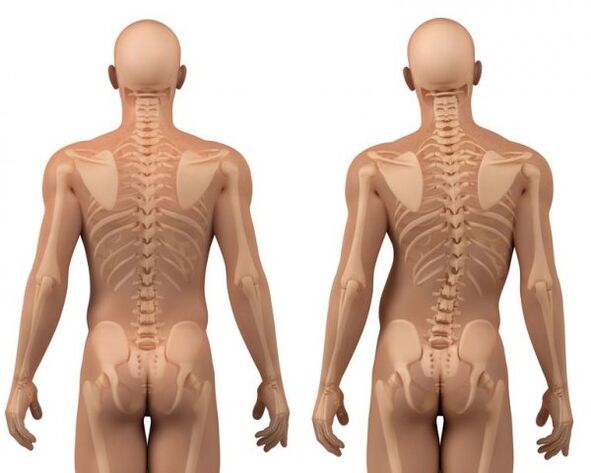
Other symptoms of scoliosis:
- Chest deformity. There is a displacement of the ribs and vertebrae, which leads to damage to the spinal cord and its branches. Therefore, back pain is observed on the left side below the shoulder blade or on the right side.
- Respiratory disorder. Due to the deformation of the chest, lung dysfunction is noticed - one is compressed, the other tries to compensate for the gas exchange deficit.
- Violation of cardiac activity. Due to the distorted spine, there is difficulty in breathing, the skin becomes pale, the pulse changes.
Note!Scoliosis is characterized by compression of the spinal cord, so the discomfort is localized between the scapulae or below them. The pathological focus has clear outlines and can extend to nearby areas only with muscle spasms.
Kyphosis
Kyphosis is a curvature of the spine backwards, in which the shoulder girdle is pulled forward, bending occurs. In this case, the pain is localized above the shoulder blades, it is bilateral in nature, radiating to the neck, arm.
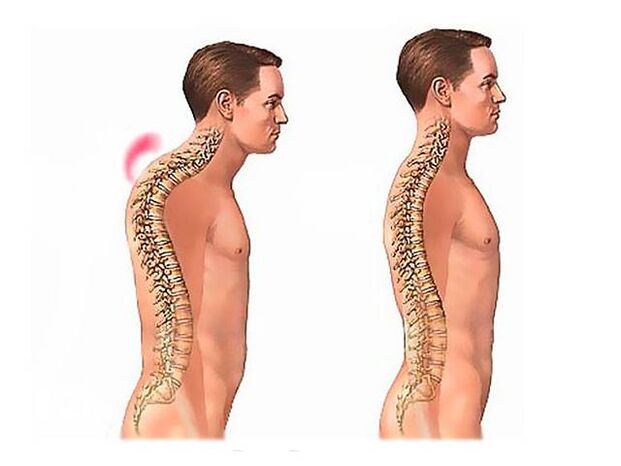
Mechanisms of kyphosis pain:
- Muscular. The curvature of the spine leads to excessive tension of the muscles of the collar zone and their spasm, which is accompanied by pain over the shoulder blades.
- Neurogenic. In the background of the curvature of the spine, the distance between the vertebrae decreases. This leads to disruption of the spinal cord branches and the appearance of pain in the area of the shoulder blades, which can extend to the neck, collarbone, shoulder.
With kyphosis, the vertebral artery is constricted, which leads to worsening of cerebral circulation, dysfunction of internal organs.
Radiculitis
The pathology is characterized by pinching of the lumbar roots that make up the sciatic nerve. By defeat of the upper part the pain is localized under the scapula and below it. The discomfort is mutual, it is more pronounced with sudden movements.
If left untreated, sciatica is accompanied by other symptoms:
- burning pain in the back (below the shoulder blades and lower back) - indicates pinching of the spinal root;
- lumbago with irradiation in the leg;
- convulsions;
- violation of sensitivity in the buttocks, lower back;
- numbness along the nerve (can be noticed in the lower leg, thigh, foot).
Neuralgia
Inflammation of nerve fibers in this anatomical region can cause pain under the shoulder blades. A common cause of pathology is hypothermia.
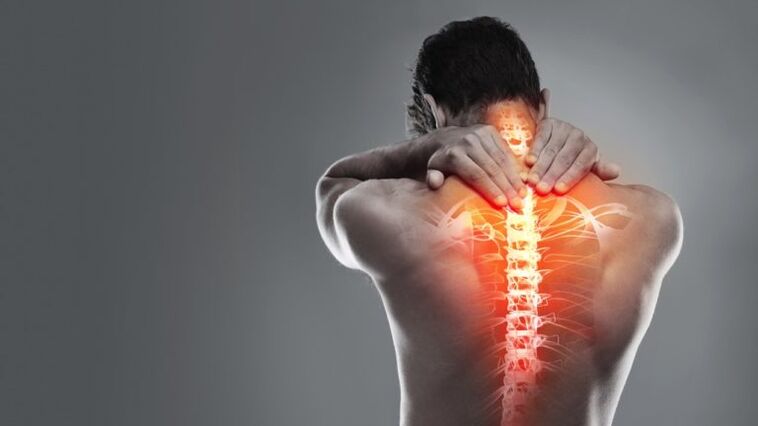
Inflammation can affect structures such as:
- Intercostal nerves. 1-4 pairs located along the lower edge of the ribs are affected. The pain is localized below the shoulder blades and below, in the lateral parts of the thorax, it rarely extends to its front parts.
- Supraspinatus and supracapular nerves. It is characterized by the appearance of pain in the area of the shoulder blades from the back in the area of the clavicle. Sometimes the symptom spreads to the shoulders.
- Infraspinatus and subcapular nerve. Discomfort is felt under the shoulder blade on the left or right side. When the inflammation spreads to the muscles, the pain increases when you move your arms.
Note!In neuralgia, the pain is often unilateral in nature - the symptom is localized in the part that has suffered hypothermia.
Shoulder-scapular periarthrosis
It is characterized by inflammation of the shoulder joint and surrounding tissues. It is accompanied by impaired mobility, which can be removed only after warming up the muscles.
In humeroscapular periarthrosis, discomfort is observed at the scapular level and below. In the initial phase, it occurs after intense physical activities, as the disease progresses - at rest. Other symptoms of pathology:
- numbness of the upper limbs;
- headache;
- reduced spinal mobility.
Heart pathology
Pain under the shoulder blades may indicate heart disease. This is due to the fact that the branches of the parasympathetic trunk connected to the spinal cord and nerve roots go to the organ. If the back of the left shoulder blade hurts from the back, there is a symptom that may indicate a mild form of myocardial infarction. It can last for several days, increase with movement and decrease at rest.
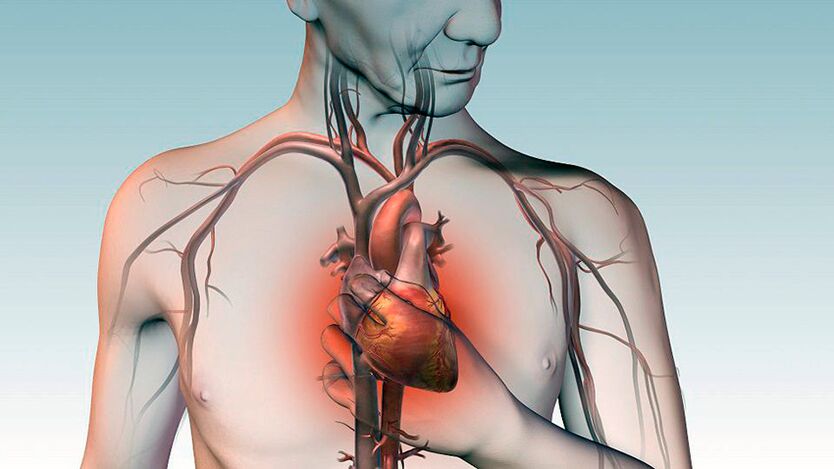
Other signs of pathology:
- tingling, pain under pressure behind the chest;
- heart rhythm disorder;
- palpitations;
- dyspnea;
- dizziness;
- nausea, vomiting;
- high blood pressure.
Diseases of the digestive system
The mechanism of pain is similar to the previous reason - spreading along nerve fibers. The localization of symptoms depends on the affected organ, rarely the discomfort is bilateral.
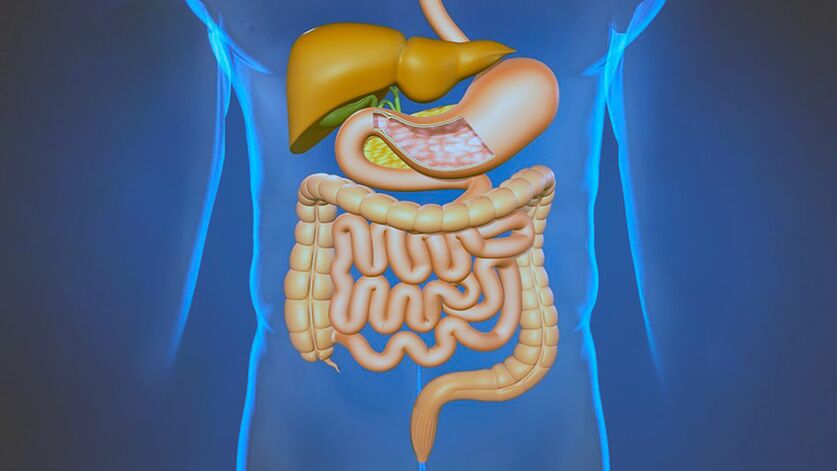
If the back hurts to the left below the shoulder blade, the development is possible:
- inflammation of the gastric mucosa;
- pancreatitis (inflammation of the pancreas);
- stomach ulcer.
In addition, such pathologies include nausea, vomiting, heartburn, belching, and heaviness in the abdomen. If the ulcer is complicated by internal bleeding, there is pale skin, decreased blood pressure, weakness, darkening of feces.
Feelings of discomfort under the right shoulder blade may indicate such diseases:
- duodenal ulcer;
- hepatitis;
- cirrhosis of the liver;
- cholelithiasis.
Other causes of symptoms
The following factors can also cause pain in the shoulder blade area:
- Unsuitable place to sleep. In particular, a collapsed mattress and sleeping on the left side can cause pain on the opposite side, because the spine bends and the roots tighten.
- Vegetovascular dystonia. It is accompanied by a drop in blood pressure, difficulty breathing, weakened heart activity, and sometimes back pain in the shoulder blade area.
- Polio. An infectious disease in which the pain in the shoulder blades is neurogenic.
- Pleurisy. In inflammation of the pleura, the symptom occurs due to the friction of its leaves against each other. The peak of pain occurs with a deep breath.
- Kidney pathology. It is characterized by aching, stabbing pain below the right shoulder blade. In addition, there is a change in urine color and urine excretion.
- Intoxication. Discomfort occurs when excess toxins or breakdown products accumulate in the body against the background of a cold or due to severe poisoning. It is accompanied by cold, muscle aches, fever.
- Subphrenic abscess. Pain under the shoulder blades is noticed when inhaling, and is caused by the accumulation of pus in the upper abdominal cavity.
- Mental disorders. Sometimes mental disorders are accompanied by discomfort in the back, but the mechanism of its development has not been studied yet.
Types of pain
The nature of the pain in the shoulder blade area can vary. Depending on this criterion, it is possible to assume a possible disease and determine the cause of discomfort:
- Shooting, sharp, occurs when turning the body or moving. Typical of pinched nerves. This feature allows to distinguish it from pain in gallstone disease - with this diagnosis the discomfort is constant and does not depend on movements.
- Cutting, dull pains of varying intensity. May indicate neuralgia, inflammation of the joints.
- Pulsating, pain or burning. Such pain in the area of the shoulder blades indicates diseases of the internal organs. The symptom develops as a result of compression of the nerve roots, and may become more pronounced with movement.
- Choking pain at or below the level of the shoulder blades. Typical of spinal hernia. Often accompanied by numbness of the arms or legs, lumbago.
Which doctor should I go to?
If painful sensations occur in the shoulder blade area, you should make an appointment with a neurologist. The doctor will perform an examination, establish a diagnosis and determine treatment tactics. In case of detection of pathologies of internal organs, it will be referred to a specialist of a narrow profile - gastroenterologist, cardiologist, orthopedist (depending on the alleged diagnosis).
Poll
To determine the cause of pain in the shoulder blade area, patients are assigned the following diagnostic procedures:
- Clinical tests of blood, urine. They show inflammatory changes, help in the diagnosis of somatic diseases.
- X-ray examination, CT. They enable you to detect the curvature of the spine, injuries and their consequences, osteochondrosis.
- Ultrasound. It is used to identify pathologies of internal organs.
- ECG. Informative in case of suspected heart disease.
- MRI. It reflects the condition of the spine, shoulder girdle, internal organs. The area of investigation is determined by the physician depending on the proposed diagnosis.
Note!Pain under the shoulder blades often indicates neurological abnormalities. Therefore, CT and MRI are the "gold standard" in determining the cause of symptoms.
Treatment characteristics
The goal of treatment is not only to remove the pain, but also to remove the factor that leads to its occurrence. When medical help is sought, the pain syndrome is alleviated in parallel, as well as the appointment of etiological treatment aimed at eliminating the underlying disease.
The therapeutic program may include the following methods:
- Treatment. A number of analgesics and anti-inflammatory drugs are used to relieve pain. Depending on the cause of the symptoms, antibacterial agents, diuretics, gastroprotectors, etc. may be used.
- Physiotherapy. It helps speed up recovery from somatic pathologies, strengthens the spine. Electrophoresis, UHT, and warm-up procedures are used to relieve pain in the scapular area.
- Massage. It helps to eliminate muscle cramps, improve posture, relieve painful sensations. It is prescribed for spinal problems. Sometimes the intervention of an osteopath or chiropractor is needed.
- Gymnastics. It is displayed during the recovery period. A set of exercises is selected for each patient individually, depending on the established diagnosis.
How to prevent discomfort in the shoulder blade area?
Every patient who undergoes a course of treatment is recommended to follow a series of preventive measures. They are necessary to prevent the recurrence of the disease.
It is important to follow these rules:
- create favorable sleeping conditions - choose an orthopedic pillow and a mattress of moderate strength that support the physiological position of the spine;
- pay attention to posture;
- follow the principles of proper nutrition;
- try to prevent exacerbation of chronic pathologies;
- give up addiction (smoking, drinking alcohol);
- See your doctor regularly for preventative checkups.
Scapular pain can be caused by somatic and neurological causes. In the latter case, the symptom appears abruptly and is pronounced. Of somatic origin, the pain grows gradually and lasts a long time, does not depend on body movements.
Analgesics can be used to relieve unpleasant symptoms. However, in order to completely eliminate feelings of pain, it is important to undergo a comprehensive course of treatment aimed at eliminating the underlying pathology. Only a doctor can develop the correct course of therapy after a complete examination.



































